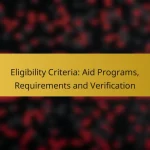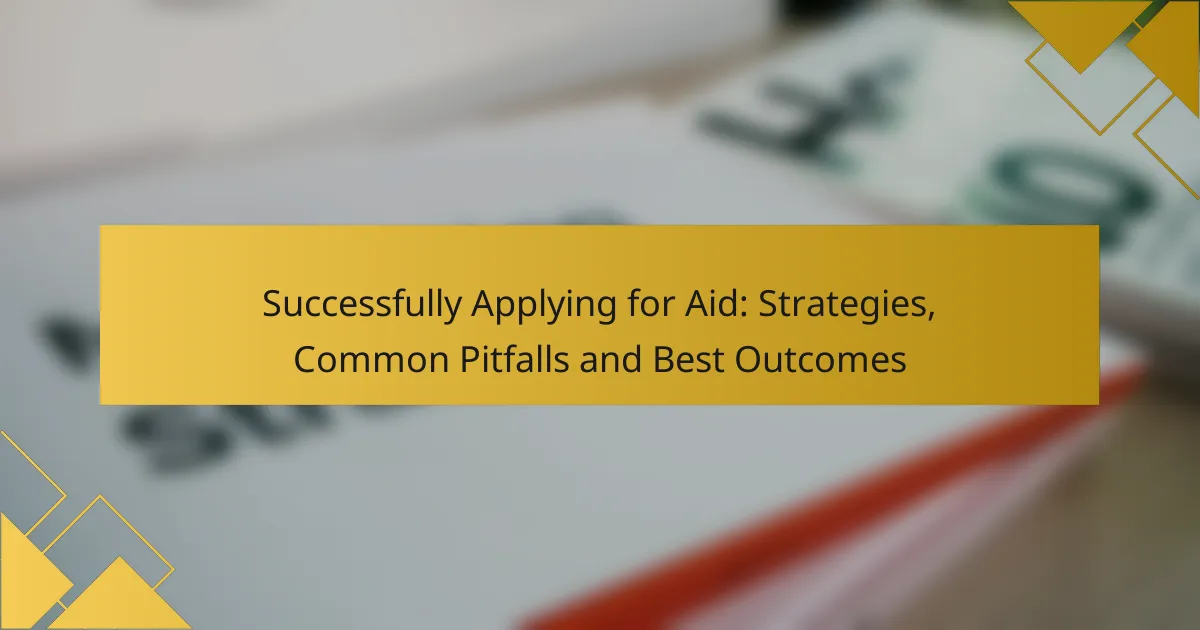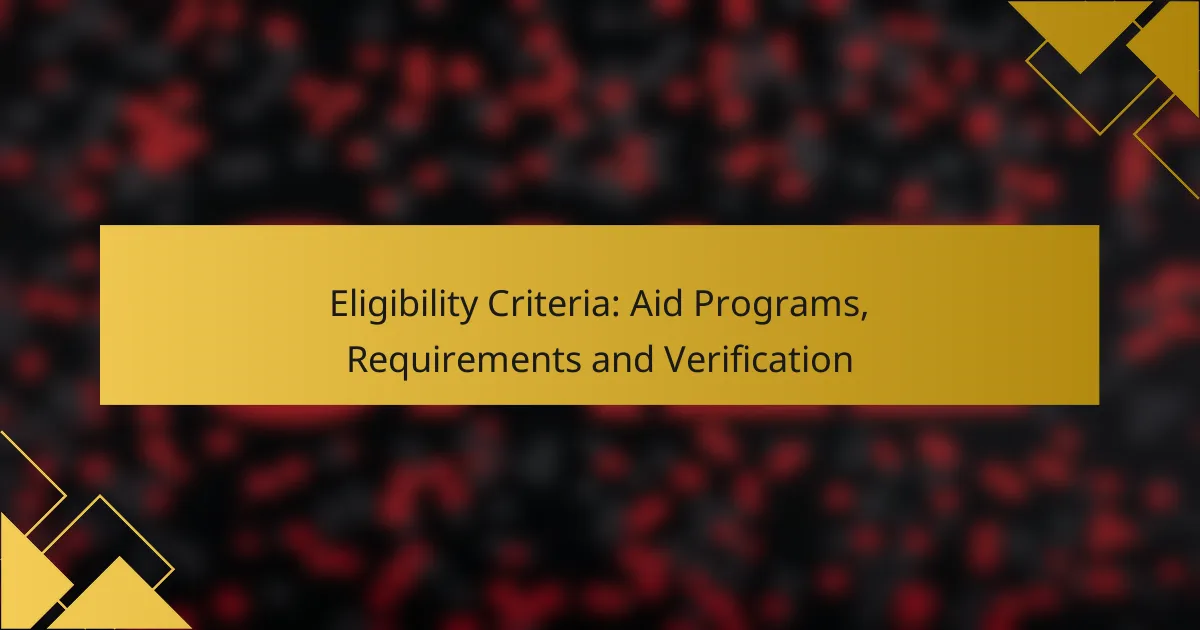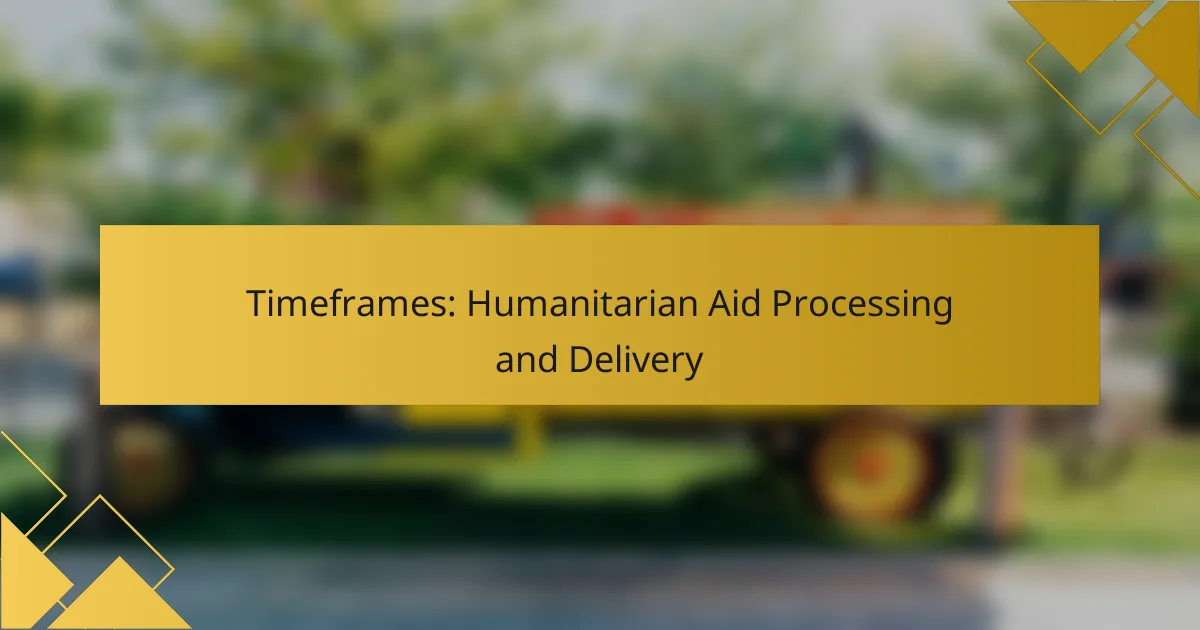Successfully applying for aid requires a strategic approach that combines tailored materials, effective communication, and an understanding of local resources. By avoiding common pitfalls such as incomplete documentation and missed deadlines, applicants can significantly improve their chances of receiving support. Clearly articulating personal circumstances and providing compelling evidence are essential for crafting a persuasive application that resonates with decision-makers.

What strategies can improve aid application success?
Improving aid application success involves a combination of tailored materials, effective communication, and leveraging local resources. By focusing on these strategies, applicants can enhance their chances of receiving the support they need.
Tailored application materials
Creating tailored application materials is crucial for demonstrating your specific needs and circumstances. Personalize your application by including relevant details about your situation, such as financial hardships or unique challenges faced.
Ensure that all documents are clear, concise, and free of errors. Consider using bullet points to highlight key information, making it easier for reviewers to grasp your situation quickly.
Clear communication of needs
Clearly articulating your needs is essential in aid applications. Be direct and specific about what assistance you require, whether it’s financial support, food, housing, or medical aid.
Use straightforward language and avoid jargon. Providing a brief narrative that outlines your circumstances can help reviewers understand your situation better and the urgency of your request.
Utilizing local resources
Local resources can significantly enhance your aid application process. Research community programs, government services, and non-profit organizations that offer assistance in your area.
These resources often have specific knowledge about local aid opportunities and can provide guidance on completing applications effectively. They may also offer workshops or one-on-one support to help you navigate the process.
Engaging with community organizations
Connecting with community organizations can provide valuable support during the application process. These organizations often have experience in helping individuals apply for aid and can offer insights into what works best.
Consider attending local meetings or events to network with representatives from these organizations. Building relationships can lead to additional resources and advocacy on your behalf.
Following up with aid providers
Following up with aid providers after submitting your application is a critical step. A polite inquiry about the status of your application can demonstrate your commitment and keep your request top of mind.
Be prepared to provide any additional information they may need. Following up can also help clarify timelines and expectations, ensuring you stay informed about the process.

What common pitfalls should be avoided?
Avoiding common pitfalls is crucial for successfully applying for aid. Key areas to focus on include ensuring complete documentation, meeting deadlines, understanding eligibility criteria, and seeking assistance when needed.
Incomplete documentation
Submitting incomplete documentation is a frequent mistake that can delay or derail your application. Ensure that all required forms, identification, and supporting documents are included and clearly labeled.
Checklists can be helpful. Create a list of all necessary documents based on the aid program’s requirements and verify that each item is complete before submission.
Missing deadlines
Missing deadlines can result in automatic disqualification from receiving aid. Each program has specific timelines for applications, so it’s essential to be aware of these dates and plan accordingly.
Consider setting reminders well in advance of the deadlines. This proactive approach can help you allocate sufficient time to gather documents and complete your application without last-minute stress.
Overlooking eligibility criteria
Overlooking eligibility criteria can lead to wasted effort in applying for aid you do not qualify for. Carefully review the requirements for each program to ensure you meet all necessary conditions.
Take note of factors such as income limits, residency requirements, and specific demographic criteria. This understanding can save you time and help you focus on programs that align with your situation.
Neglecting to seek assistance
Neglecting to seek assistance can leave you feeling overwhelmed and unsure about the application process. Many organizations offer guidance and support for applicants, which can be invaluable.
Don’t hesitate to reach out to local aid offices or community organizations. They can provide insights, answer questions, and help you navigate the application process more effectively.

How can applicants effectively present their case?
Applicants can effectively present their case by clearly articulating their circumstances, demonstrating their needs, and providing compelling evidence. A well-structured application that combines personal narratives with factual support increases the likelihood of receiving aid.
Highlighting personal stories
Personal stories can create an emotional connection with the reviewers, making the application more relatable. Sharing specific experiences that illustrate challenges faced can help convey the urgency and importance of the aid being requested.
For example, detailing a significant life event, such as a job loss or a medical emergency, can provide context for financial needs. Ensure that the narrative is concise and directly relevant to the aid being sought.
Providing supporting evidence
Supporting evidence strengthens an application by validating claims made in personal stories. This can include documents such as pay stubs, medical bills, or letters from employers that confirm the applicant’s situation.
Organizing evidence in a clear manner, such as using bullet points or tables, can help reviewers quickly grasp the applicant’s circumstances. Ensure that all documents are current and relevant to the aid request.
Demonstrating financial need
Clearly demonstrating financial need is crucial for aid applications. This involves providing a detailed overview of income, expenses, and any debts, allowing reviewers to assess the applicant’s financial situation accurately.
Consider including a simple budget breakdown that outlines monthly income versus expenses. This transparency can help justify the request for assistance and highlight the necessity of support.

What resources are available for aid applicants?
Aid applicants can access a variety of resources to help navigate the application process, including government websites, nonprofit organizations, and local community centers. These resources provide essential information, support, and guidance tailored to specific needs and circumstances.
Government websites
Government websites serve as a primary resource for aid applicants, offering comprehensive information about available programs and eligibility criteria. Websites such as Benefits.gov in the United States or Gov.uk in the UK provide centralized access to various forms of assistance, including financial aid, housing support, and healthcare services.
When using government websites, ensure you have the necessary documentation ready, such as identification and income statements, to streamline the application process. Be cautious of deadlines and specific requirements for each program to avoid common pitfalls.
Nonprofit organizations
Nonprofit organizations play a vital role in supporting aid applicants by providing resources, advocacy, and direct assistance. Organizations like the Salvation Army or local food banks often offer services ranging from emergency financial aid to job training programs.
To make the most of nonprofit resources, research local organizations that align with your specific needs. Many nonprofits also provide workshops or one-on-one consultations to help applicants understand the aid process and avoid mistakes.
Local community centers
Local community centers are valuable hubs for aid applicants, offering workshops, informational sessions, and direct assistance with applications. These centers often collaborate with government agencies and nonprofits to provide a comprehensive support network.
Visit your nearest community center to learn about upcoming events or resources available in your area. Engaging with staff can provide personalized guidance and help you connect with additional services that may be beneficial for your situation.

How does the application process vary by region?
The application process for aid can differ significantly depending on the region, influenced by local regulations, available resources, and specific eligibility criteria. Understanding these regional variations is crucial for applicants to navigate the system effectively and maximize their chances of success.
State-specific requirements
Each state has its own set of requirements for aid applications, which may include documentation, income thresholds, and residency criteria. For example, some states may require proof of income through tax returns or pay stubs, while others might accept self-declared income statements. Familiarizing yourself with your state’s specific requirements can prevent delays and rejections.
Additionally, deadlines for applications can vary widely. Some states have rolling deadlines, while others may have fixed dates tied to fiscal years or specific programs. Always check your state’s official website for the most accurate and up-to-date information.
Regional funding opportunities
Funding opportunities can differ not only by state but also by region within a state. Urban areas might have access to more diverse funding sources, including local grants and private foundations, compared to rural regions. Researching regional funding opportunities can reveal unique programs tailored to local needs.
Consider utilizing online databases or local government resources to identify available funding options. Many regions also have specific programs aimed at supporting underserved populations, which can provide additional avenues for financial assistance.
Local support networks
Local support networks play a vital role in the aid application process, offering guidance and resources to applicants. These networks may include community organizations, non-profits, and advocacy groups that specialize in helping individuals navigate the complexities of aid applications.
Engaging with local support networks can provide valuable insights into the application process, including tips on avoiding common pitfalls. Many of these organizations also offer workshops or one-on-one assistance, which can enhance your understanding and improve your application’s quality.

What are the best practices for following up on applications?
Following up on applications is crucial to demonstrate your interest and ensure your submission is being processed. Best practices include timing your follow-ups appropriately and using clear, concise communication.
Timing your follow-up
Timing is essential when following up on applications. Generally, wait about one to two weeks after submitting your application before reaching out. This allows sufficient time for the review process while showing your eagerness.
If the application specifies a timeline for decisions, align your follow-up with that schedule. For instance, if a grant application states that decisions will be made within 30 days, consider following up a few days after that period has elapsed.
Crafting your message
Your follow-up message should be professional and to the point. Start by expressing appreciation for the opportunity and briefly mention your application. For example, “I hope this message finds you well. I am writing to inquire about the status of my application for [specific aid program].”
Keep your message concise, ideally no longer than a few sentences. Avoid overwhelming the recipient with excessive details or questions. Instead, focus on your main inquiry and express your willingness to provide any additional information if needed.
Common pitfalls to avoid
One common pitfall is following up too soon or too frequently. This can come across as impatient and may negatively impact your application. Stick to the recommended one to two-week timeframe unless otherwise indicated.
Another mistake is sending vague or overly complex messages. Ensure your follow-up is clear and directly related to your application. Avoid using jargon or overly technical language that may confuse the recipient.
Best outcomes from effective follow-ups
Effective follow-ups can lead to positive outcomes, such as receiving timely updates or even feedback on your application. Demonstrating your proactive approach can also leave a favorable impression on decision-makers.
Ultimately, a well-timed and well-crafted follow-up can enhance your chances of success by keeping your application top of mind and showing your commitment to the process.










